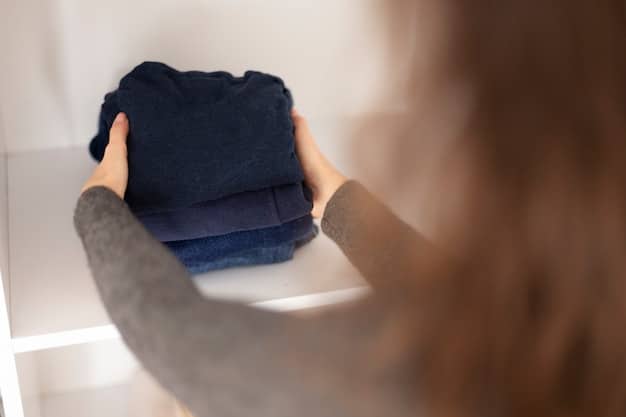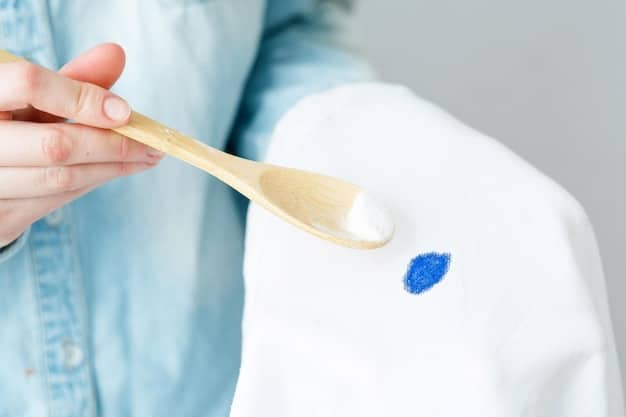How to Care for Your Clothes: Expert Tips for a 50% Longer Wardrobe Life

Caring for your clothes properly can significantly extend their lifespan by up to 50%, saving you money and reducing textile waste through simple washing, storing, and repair techniques.
Want to make your clothes last longer? How to Care for Your Clothes: Expert Tips for Extending the Life of Your Wardrobe by 50% will help you keep your favorite items looking great and staying wearable for years to come.
Master the art of laundering: Washing your clothes the right Way
Washing clothes seems straightforward, but incorrect methods can damage fabrics and shorten their lifespan. Understanding proper laundering techniques can make a huge difference.
Learn how to wash smarter and keep your clothing like new.
Sorting Like a pro
Sorting your clothes before washing is a crucial first step. Separate items by color and fabric type to prevent color bleeding and damage.
Temperature Matters
Using the right water temperature can protect your clothes, hot water is best for whites and heavily soiled items, while cold water is gentle on colors and delicate fabrics.
- Use cold water for dark colors to prevent fading.
- Wash delicate fabrics in cold water to avoid shrinking or damage.
- Always check the care label for specific temperature recommendations.
With the right water temperature ,you can wash your clothes longer.
The ultimate guide to drying clothes: Preventing shrinkage and damage
Drying clothes can be trickier than washing. High heat can cause shrinkage, fading, and damage to fabrics. Mastering drying techniques helps to preserve your wardrobe for longer.
From air drying to using your dryer smarter, discover the best practices.

Air Drying Advantages
Air drying is one of the gentlest methods for drying clothes. It prevents shrinkage and reduces wear and tear on fabrics.
Dryer Settings Explained
Understanding your dryer settings is key to avoid damage. Use low heat settings for delicate items and avoid over-drying clothes.
- Use a low heat setting for delicate fabrics to prevent shrinking.
- Avoid over-drying clothes, as it can damage fibers and cause static cling.
- Dry similar items together to ensure even drying.
Using an appropriate dryer setting , you are preserving your clothes.
Folding and storing clothes like a stylist
How you fold and store your clothes can impact their condition. Proper folding and storage prevent wrinkles, stretching, and damage.
Organize your closet to keep your clothes in excellent condition and also easy to find what you need.
Folding Techniques
Efficient folding techniques save space and minimize wrinkles. Fold clothes neatly and uniformly to maximize storage space.
Storage Solutions
Choosing the right storage solutions can protect your clothes from dust, moths, and other damage. Use garment bags for delicate items and cedar blocks to repel moths.
Use the right storage solutions in order to keep your clothes safer and lasting longer.
Essential tips for stain removal: Saving clothes from permanent marks
Stains happen, but knowing how to remove them can save your favorite clothes. Act quickly and use the right techniques.
Don’t let a stain ruin your clothes. Learn effective removal methods to keep your wardrobe looking fresh.

Act Fast
The quicker you treat a stain, the easier it is to remove. Blot the stain immediately and avoid rubbing, which can spread it.
Use the Right Products
Different stains require different treatments. Keep a variety of stain removers on hand, including enzyme cleaners, stain sticks, and hydrogen peroxide.
- Always test stain removers on a hidden area of the fabric first.
- Use cold water to rinse out most stains, as hot water can set some stains.
- Treat stains from the inside out to prevent spreading.
Acting quickly will help you remove stains effectively and make your clothes last longer.
Repair and alteration: Mending clothes to prolong their life
Repairing and altering clothes is a sustainable way to extend their lifespan. Simple mending and alterations can make old clothes feel new again.
Learn some simple stitches to become more helpful and efficient.
Basic Sewing Skills
Learning basic sewing skills allows you to repair tears, reattach buttons, and fix hems. A simple needle and thread can work wonders.
Alterations for a Perfect Fit
Altering clothes to fit you perfectly can make them more comfortable and wearable. Adjust hems, take in seams, and replace zippers to customize your wardrobe.
- Reinforce weak seams to prevent tears and rips.
- Replace worn zippers to keep your clothes functional.
- Patch small holes in fabrics to extend their life.
Repairing and altering your clothes will make them last longer.
Protecting clothes from pests: Preventing moths and other damage
Pests like moths can wreak havoc on your clothes when not properly taken care of. Keeping your closet clean and using preventative measures can protect your wardrobe.
Protect clothes from pests that can destroy them.
Keep a Clean Closet
Regularly clean your closet to remove dust, dirt, and potential food sources for pests. Vacuum the floors and wipe down shelves to maintain a pest-free environment.
Natural Repellents
Use natural repellents like cedar blocks, lavender sachets, and mothballs to deter pests. Place these items in your closet and drawers to protect your clothes.
- Store out-of-season clothes in airtight containers to prevent pest infestations.
- Inspect your clothes regularly for signs of damage.
- Use cedar hangers to repel moths naturally.
Use closet repellents to keep your clothes from being infested.
Seasonal storage: Preparing clothes for long-term keeping
Proper seasonal storage is crucial for preserving clothes you won’t be wearing for a while. Protect your garments from dust, pests, and environmental damage.
Store clothes properly to ensure they remain in good condition when you need them again.
Clean Before Storing
Always clean your clothes before storing them to remove stains, dirt, and odors. Stains can set over time, and odors can attract pests.
Use Airtight Containers
Store clothes in airtight containers or garment bags to protect them from dust, moisture, and pests. Vacuum-sealed bags are excellent for saving space.
With seasonal storage your clothes will last longer.
| Key Point | Brief Description |
|---|---|
| 🧺 Proper Washing | Use cold water for colors, hot for whites; sort by fabric. |
| ☀️ Air Drying | Prevents shrinkage and reduces wear on fabrics, Eco-friendly. |
| 🪡 Quick Repairs | Mend tears, replace buttons to extend garment life. |
| 🐛 Pest Control | Clean closet, use cedar, and airtight containers. |
FAQ: Answers to Your Clothing Care Questions
▼
Sort clothes by color (lights and darks) and fabric type (delicates, heavy fabrics) to prevent color bleeding and damage. Always check pockets.
▼
Wash jeans sparingly, only when visibly dirty or smelly, to maintain their shape and color. Spot clean when possible for better results.
▼
Clean before storing, use airtight containers, and store in a cool, dry place. Add cedar chips to repel pests and keep items fresh.
▼
Re-treat the stain with a stain remover and wash again. Avoid drying the item until the stain is completely gone, as heat can set it.
▼
Keep your closet clean, use cedar blocks or lavender sachets, and store clothes in airtight containers. Regularly inspect for signs of moth infestation.
Conclusion
By following these expert tips on how to care for your clothes: Expert tips for Extending the Life of Your Wardrobe by 50%, you can significantly extend the lifespan of your wardrobe, saving money and reducing textile waste. Simple changes in washing, drying, storing, and repairing your clothes can make all the difference. Embrace these practices to keep your clothes looking great for years to come. You’ll be able to save a lot of money doing so.





